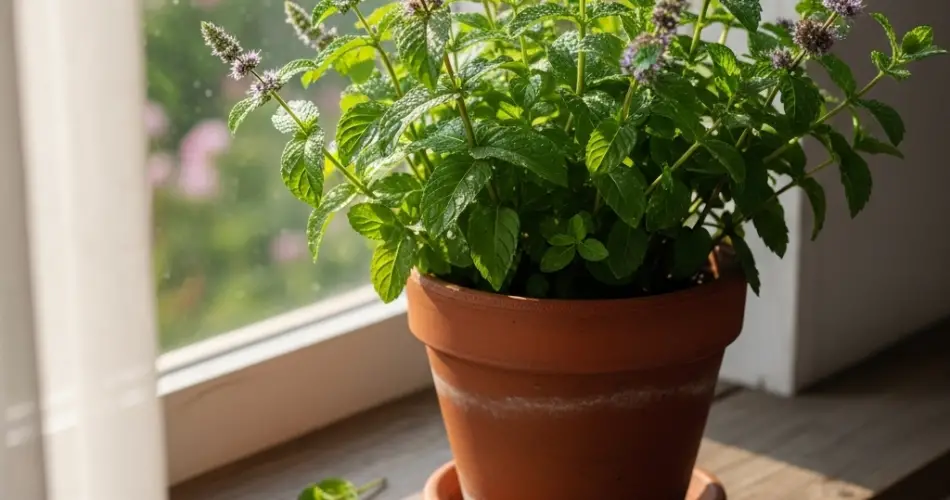Mint is one of the easiest and most rewarding herbs to grow, providing fragrant leaves that can be used in teas, desserts, salads, and savory dishes. Known for its refreshing aroma and rapid growth, mint is perfect for container gardening, especially if you want to keep it from spreading uncontrollably in your garden beds. By growing mint in pots, you can enjoy a constant supply of fresh leaves right at your fingertips without worrying about invasive roots taking over your space.
This guide will walk you through everything you need to know to grow healthy, thriving mint plants in containers.
Why Choose Containers for Mint?
Mint is a vigorous grower with underground runners that spread quickly. In the ground, it can overtake other plants if left unchecked. Containers help you:
-
Control growth: Prevent mint from spreading uncontrollably.
-
Enjoy portability: Move pots to catch more sun or bring indoors during harsh weather.
-
Save space: Ideal for balconies, patios, or windowsills.
-
Keep fresh supply close: Easily accessible for harvesting while cooking or making drinks.
Selecting the Right Container
Choose a container that’s at least 8–10 inches deep and has drainage holes at the bottom. Mint enjoys slightly moist soil, but standing water can lead to root rot, so good drainage is essential.
Material options include:
-
Plastic pots: Lightweight and easy to move.
-
Terracotta pots: Breathable but may require more frequent watering.
-
Wooden planters: Rustic look, but line them with plastic to retain moisture.
If you plan to grow multiple varieties of mint, use separate containers to keep flavors distinct.
Soil and Planting
Mint thrives in rich, well-draining soil. Use a high-quality potting mix enriched with organic matter such as compost. Avoid heavy garden soil, which may compact and reduce root health.
You can start mint from:
-
Seeds: Sow thinly, cover lightly, and keep soil moist until germination (7–14 days).
-
Cuttings: Place a stem cutting in water until roots form, then transfer to soil.
-
Small plants: Transplant nursery-bought seedlings directly into pots.
Plant mint near the center of the container and allow enough space for it to spread across the surface.
Light and Temperature Requirements
Mint prefers full sun to partial shade. Ideally, give it 4–6 hours of sunlight daily. In very hot climates, provide some afternoon shade to prevent leaf scorch.
Temperature-wise, mint is quite hardy and can tolerate cooler weather, but growth slows significantly in frost. In colder regions, bring the container indoors before the first frost and place it in a bright, sunny spot.
Watering and Humidity
Mint loves consistently moist soil, but it should never be soggy. Water deeply whenever the top inch of soil feels dry. During hot weather, you may need to water daily, especially for terracotta pots that dry out faster.
For indoor mint, occasional misting can help maintain humidity and keep leaves fresh.
Fertilizing for Healthy Growth
Mint doesn’t need heavy feeding. Apply a balanced liquid fertilizer every 4–6 weeks during the growing season. Organic options like compost tea or diluted fish emulsion work well and help maintain strong flavor.
Avoid excessive fertilization, which can cause mint to grow too quickly and produce leaves with a weaker aroma.
Pruning and Harvesting
Regular pruning keeps mint bushy and prevents it from becoming leggy. Pinch back stems when the plant reaches about 4–6 inches in height to encourage branching.
For harvesting:
-
Snip stems just above a set of leaves to promote new growth.
-
Harvest no more than one-third of the plant at a time.
-
Pick leaves regularly to keep the plant productive.
If flower buds appear, pinch them off immediately to keep the flavor strong.
Pest and Disease Management
While mint is relatively pest-resistant, it can occasionally attract:
-
Aphids
-
Spider mites
-
Whiteflies
Rinse leaves with water or use insecticidal soap for control. To avoid fungal issues, ensure good air circulation and water at the base instead of wetting the leaves.
Overwintering Mint in Containers
In mild climates, mint can survive outdoors year-round. In colder regions, move pots indoors before frost. Keep plants in a cool, bright spot and water sparingly until spring.
Creative Uses for Fresh Mint
Homegrown mint can be enjoyed in many ways:
-
Freshly brewed mint tea
-
Mojitos and other cocktails
-
Fruit salads and desserts
-
Savory lamb dishes
-
Cooling cucumber and mint water
Having it in a container means you can harvest fresh leaves whenever inspiration strikes.
Conclusion
Growing mint in containers is a simple, rewarding gardening project that yields flavorful leaves for culinary and medicinal uses. With the right container, soil, and care, you can keep mint thriving indoors or outdoors while preventing it from overtaking your garden. By pruning regularly, watering consistently, and giving your plant plenty of light, you’ll enjoy a steady supply of aromatic leaves all year long.
Whether you’re an experienced gardener or just starting out, a pot of mint is a fresh, fragrant addition to any home.



